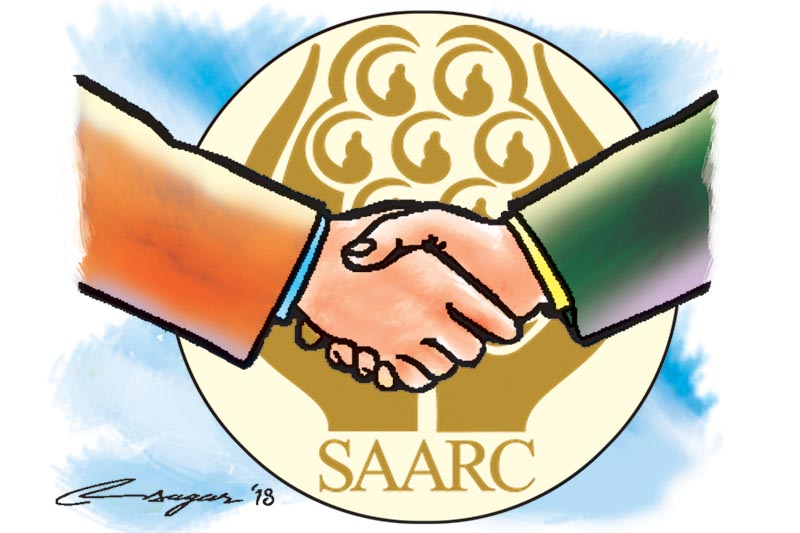SAFTA and Nepal: Time for paradigm shift
Nepal must make a quick and prudent decision to reap benefits from SAFTA. This means a paradigm shift from the traditional ‘import-based revenue policy’ to the “wider economy benefit policy”
Regional and free trade agreements are becoming the norm even in the international trading system. However, trade and investment among member countries of SAARC (South Asian Association for Regional Cooperation) is so far poor compared to other regional arrangements such as Association of Southeast Asian Nations (ASEAN).
South Asian Free Trade Area (SAFTA) is a proposed “free trade area” between the original seven members of SAARC – Bangladesh, Bhutan, India, Maldives, Nepal, Pakistan, Sri Lanka. Later in 2007, Afghanistan became the eighth member of SAARC.
The Preamble to the Agreement on SAFTA anticipates it to act as an impetus to the strengthening of national and SAARC economic resilience, and the development of the national economies of member countries by creating investment and production opportunities through the expansion of trade. The region is heavily dependent on the two largest economies for their regional trade.
Promoting and enhancing mutual trade and ensuring equitable benefits in the region through trade and investment for mutual benefits are the major guiding principles of SAFTA. The agreement incorporates trade in goods and services. The ultimate aim of SAFTA is to put in place a full-fledged South Asia economy by maintaining common tariff and non-tariff barriers on imports from all non-member countries. Accordingly, negotiation of SAFTA seems to be moving towards that direction. Nonetheless, the pace is very slow.
At the time of its adoption, all members agreed to place many products excluding them from tariff liberalisation in their individual “sensitive list”. In 2012, under Phase Two of tariff liberalisation under SAFTA, members agreed to cut their sensitive lists. However, till date the pruning has not given tangible results. South Asia has become the least integrated region in the world with less than 5 per cent of total intra-regional trade compared to East Asia’s 35 per cent and Europe’s 60 per cent.
The SAFTA Committee on Experts (COE) is tasked with finalising the negotiation process both in goods and services. Several proposals have put forwarded for discussions.
Some of the member countries have proposed that peak tariff on all products from member countries should be reduced to 0-5 per cent by 2020, excluding a small number of tariff lines, which may be allowed in the sensitive lists. Others are seeking transition and a few of have sought alternatives.
But which option will be appropriate for Nepal? It is high time we addressed this question by making a proper decision, if not an alternative proposal.
As far as service negotiation is concerned, all member states, including Nepal, have submitted their final offer and the Schedules of Specific Commitments. Hopefully, the next meeting of SAARC agreement on Trade in Services (SATIS) expert group will be able to adopt the Schedules of Specific Commitments and start negotiations.
High level trade officials and experts believe that joining SAFTA helped Nepal not only to expand its international trade but also to diversify exports to countries other than India. But Nepal’s contribution to intra-regional trade in the last 20 years has been minimal.
How can it be possible for Nepal to get benefits from SAFTA then when there is no trade, as SAFTA is neither “a care package” nor “a low-hanging fruit”?
In order for Nepal to reap benefits from SAFTA, meaningful tariff liberalisation is a must. So there are two options.
First, accept the proposal and reduce the peak tariff on all products from 0-5 per cent by 2020 while bringing down the existing sensitive list. Second, provide an alternative counter proposal to the member states before the next COE meeting.
Selection of a right alternative is quite crucial to us. Though the second option might have time-buying advantage, it could possibly be a regressive step. Time has come for us to make prudent decision. This means a paradigm shift from a traditional “import-based revenue policy” to “wider economy benefit policy”. This could be managed by enhancing national capacity not only in the public sector but also in the private sector so as to improve supply side constraints.
An equitable SAFTA may be difficult but not impossible. ASEAN has made significant progress in removing tariffs on intra-ASEAN trade, with zero rates on 99 per cent of tariff lines. ASEAN has successfully implemented some of its initiatives – the share of intra-ASEAN trade in total trade share increased to 24.2 per cent in 2013 and accounted for 25 per cent of the region’s total GDP.
Deeper economic integration is a must to sustain the growth in South Asia. This integration could also create an integrated South Asian market by ensuring a free flow of goods, services and investment.
We need to create a conducive environment for trade, investment, connectivity and competitiveness. Efforts from all members while are important, more is expected from the two large economies in the region.
Koirala, a former bureaucrat and diplomat, writes on trade, industry and transit-related issues. He also led Nepali delegation to several SAFTA COE and BMISTEC TNC meetings. He was one of the members of the negotiation team for Nepal’s accession to WTO (2001-04)






